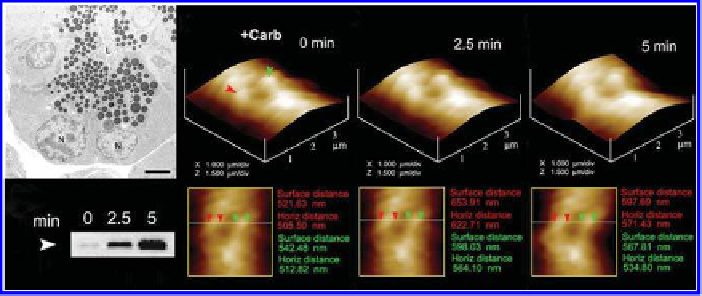Biology Reference
In-Depth Information
actually correspond to just a fraction of the vesicle content.
2-4
In the interim,
a large body of work was published both for and against the complete
merger of secretory vesicles at the cell plasma membrane during secretion,
further deepening the controversy. The only deinitive determination of the
mechanism of cell secretion relied on the direct observation of the process
at nanometre resolution in live cells. The conundrum was inally resolved
using atomic force microscopy (AFM).
5
Isolated live pancreatic acinar
cells in near-physiological buffer when imaged using AFM at high force
(200-300 pN) demonstrate the size and shape of the secretory vesicles
called zymogen granules or ZGs lying immediately below the apical
a physiological secretory stimulus (1 μM carbamylcholine), the majority
time in live cells the intracellular swelling of secretory vesicles following
stimulation of secretion and their delation following partial discharge of
vesicular contents.
5
No loss of secretory vesicles is observed throughout the
experiment, demonstrating transient fusion and partial discharge of vesicular
contents during cell secretion.
(a)
(b)
(c)
(d)
(e)
Figure 5.1.
The swelling dynamics of ZGs in live pancreatic acinar cells. (a) Electron
micrograph of pancreatic acinar cells showing the basolaterally located nucleus (N)
and the apically located ZGs. The apical end of the cell faces the acinar lumen (L).
Bar = 2.5 μm. (b-d) The apical ends of live pancreatic acinar cells were imaged by
AFM, showing ZGs (red and green arrowheads) lying just below the apical plasma
membrane. Exposure of the cell to a secretory stimulus using 1 μM carbamylcholine
resulted in ZG swelling within 2.5 minutes, followed by a decrease in ZG size after
5 minutes. The decrease in the size of ZGs after 5 minutes is due to the release
of secretory products such as α-amylase, as demonstrated by the immunoblot
assay (e).
5

















Search WWH ::

Custom Search